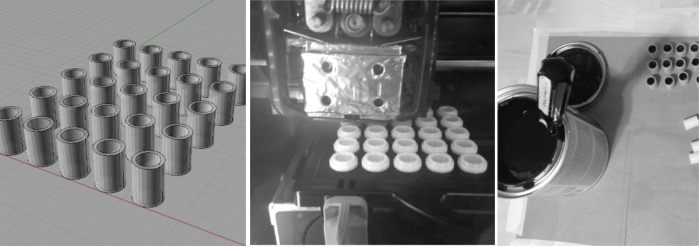About Me
I am the Director of Fab Lab Baltimore- a community workshop, fabrication lab, and educational center with about 500 members from across the Mid-Atlantic region. My work focuses primarily on responsive architectural systems. I have a Master of Architecture from Cornell University and a Bachelor of Science in Architecture from SUNY Buffalo.
In addition to participating in Fab Academy, I also currently teach a workshop series at the Johns Hopkins University Digital Media Center.
Final Project Proposal
Photometric: Robotically-Controlled Responsive Facade System

Overview
Photometric explores the emerging role of robotics in architecture, beyond tools for construction.
The project is a robotically controlled responsive facade system that modulates day-lighting levels, resulting in graphic visual patterns. It is an interactive work of art as much as it is a practical, low-cost display and sun-shading system.
The system operates by digital user input; code is translated into patterns. A multi-layer screen is controlled by a magnetic actuator hooked up to two stepper motors. The screen consists of a perforated inner layer filled with freely-sliding hollow metal pegs. This inner layer is bound by two exterior layers of clear glazing. The back layer has opaque pattern of dots corresponding to the pegs. As the actuator moves across the screen’s surface, the pegs are pulled forward to their open position, generating patterns of natural light. A similar mechanism on the backside “resets” the pegs to the closed position.
Softly illuminated patterns of natural light gradually emerge from a blank canvas, and new patterns can be generated continuously. It is about the experience as much as the final result. The system emphasizes parametric performance over static parametric design.
Precedent Studies/Prior Art
Responsive Facade Systems
Technorama Facade; Responsive Awning, MIT Kinetic Design Group; Flare Facade; Institut du Monde Arabe; Hyposurface
Robotic Systems
der Kritzler; Drawbot; Wallrus; Hektor; Polargraph; Hills We Climb; Gramazio & Kohler; General Research
Testing the Concept
This is a video to show generally how the system will work. As a magnetic actuator is slid across the surface of the screen, the pegs will pull forward, letting light pass through.
study model from Kelly Zona on Vimeo.

I began by building some of the components of my system in Rhino. The goal was to build a physical model as quickly and easily as possible. I don't think that 3d printing is the best method for this project, but this is the best option at the moment. I cut the rest of the model on the laser cutter from a simple CAD drawing. To finish, I coated the inside of the pegs with a layer of magnetic primer.
The purpose of this model is twofold: 1. Test the system's mechanics. 2. Test the system's lighting conditions. I expect that this system will change throughout the course, but this does give me a good starting point. Overall the system performed as I'd hoped, but I eventually want to achieve even more contrast between the open and closed pegs.